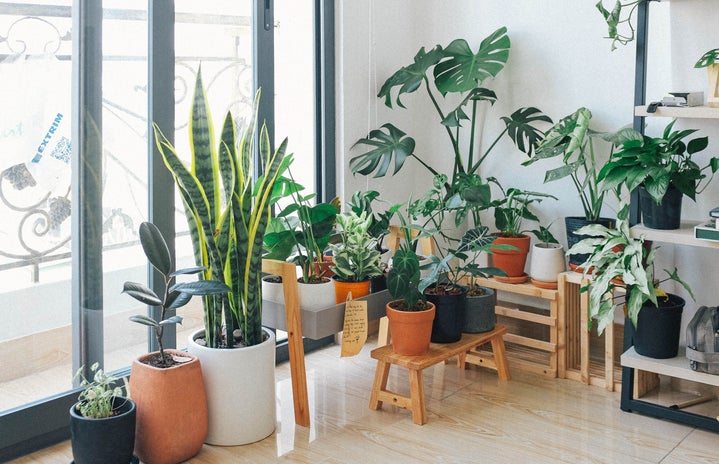As the weather warms and summertime approaches, many people have been adopting and collecting houseplants! Over the past year, plants have served as stress-relieving, air-cleaning companions in a time of crisis. I have exponentially increased my personal plant collection over the past year. I grew two spider plants over the past three years, and now I have pots scattered around my room full of seeds, sproutlings, and shiny ivy. With a bit of reading, experimentation, I’ve gotten the hang of no longer killing a hanging plant. From outdoor gardening to indoor spider plants, this is the perfect beginner’s guide to taking care of any little green-leaf miracle.

Make sure you have a perfectly-sized pot. In order to ensure no two roots are too tangled, find a ceramic pot or other container that can be used to repot a plant. As long as the plant has enough air and soil to start growing in, it has everything it needs to begin. Over time, as the plant grows, swapping pots benefits the plant as well to let it keep growing. I like to upcycle wide candle jars or soup cans. This allows for some creative expression as well; It’s fun to paint the outside of old pots and even give the plants a new name to fit their new home.
Fertilizer is an easy fix. For outdoor gardening in particular, fertilizing a plant is the best way to create nutrient-rich soil. Countertop-sized compost bins, like this one from Home Depot, hold your kitchen produce scraps and other compostable paper, leaves, and materials that breaks down and eventually turns into an environmentally-beneficial fertilizer. Making a homemade kitchen compost bin is an option, too! It is as easy as ventilating and upcycling an old container of metal pail. Adding some to a plant’s soil can rarely go wrong.
Be careful, however. Watering plants needs to be timed. Adding too much compost can go haywire if the compost is unbalanced or if there is too much liquid present. Water plants only once the soil has dried up. The plants take as much water as they need, and sometimes it takes days for the rest to evaporate. Depending on the plant, water what seems fit and let it bathe in its lovely level of sunlight.
Prune, polish, and propagate. One tip many tend to forget about, is the physical care of a plant itself. Depending on what kind of plant is being cared for, indoor or outdoor, trimming dead leaves, separating overgrown sections, and wiping away dust build-up are some of the sweetest acts one can do to help a plant out! These little clean-up services ensure the plant has enough room and is clean enough to soak in as much sunlight as it can. As an added bonus, propagating an older or larger plant gives off extra pieces that can be transplanted and grown separately as a new plant.
Keep an eye out for unusual sights. Some plants can develop a disease, showing brown or green spots on the leaves or foliage. If there’s a peculiar reason for something dying or wilting quickly, check the first four steps again and think about any contaminants that could be nearby. I made the mistake one time of placing fresh fruit scraps in a plant, and it did not go well. Just like in life, give everything to your plants in moderation.

Gaining a green thumb this year isn’t totally out of reach. With this ultimate guide to plant care, anything is possible. Will you be starting a gorgeous garden this summer? Be sure to reap the rewards, too. Eating, baking with, or gifting fresh home-grown produce is possible. Don’t forget about photographing a plant in your window sill, too. It all starts with one succulent, seed, or spider plant.



